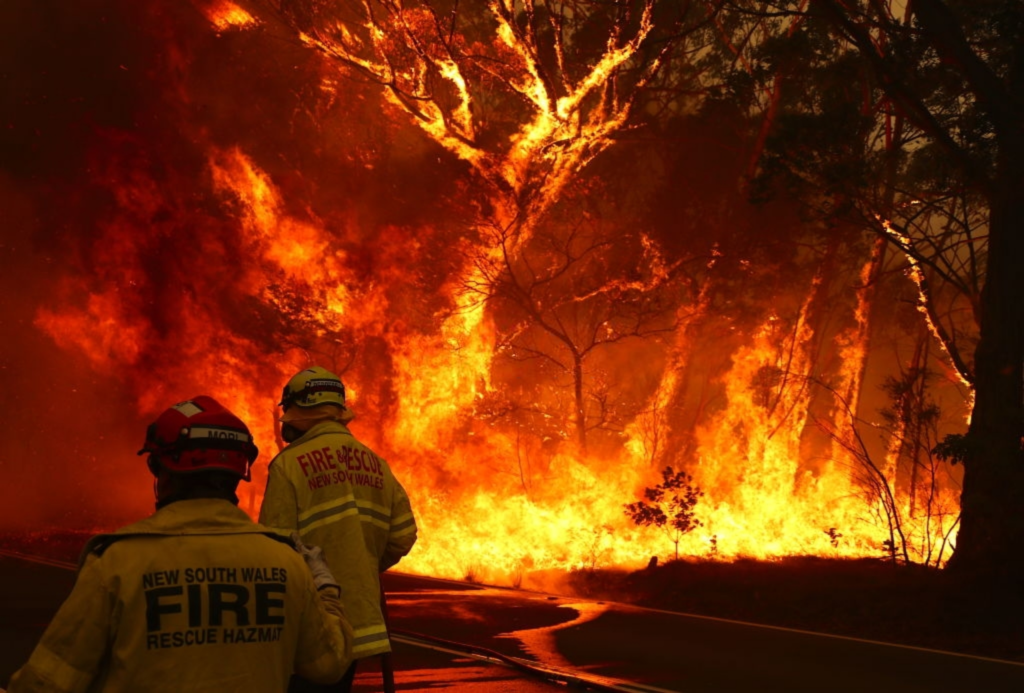Australia fires is a recurrent theme that has left a significant mark on its landscape and inhabitants. The 2019-2020 bushfire season was particularly devastating, engulfing over 90,000 square miles of land, affecting billions of animals, destroying homes, and claiming lives. This catastrophic event, along with the threat of climate change, has led to a need for a deeper exploration into why Australia fires have become a recurring event.

Australia’s Geography
Geographical factors play a crucial role in Australia fires. Known as the driest inhabited continent on Earth, approximately 70% of Australia’s landmass consists of arid or semi-arid regions, receiving minimal rainfall. The country’s location in the subtropical high-pressure belt inhibits the lifting of air required for rain, exacerbating its dry conditions. While coastal areas receive more rainfall, the moisture is quickly drained, leaving the interior parched and prone to ignition.
The vastness of Australia, encompassing both country and continent, further complicates matters. The Great Dividing Range, stretching over 2,200 miles, influences rainfall patterns, with the eastern side receiving more precipitation due to orographic lift. The majority of Australia fires are due to dry conditions. Low humidity and strong winds further escalate the intensity of fires, turning the landscape into a tinderbox waiting to ignite.
Interestingly, Australia’s flora, including iconic eucalyptus trees, has evolved mechanisms to cope with and even encourage fires. Eucalyptus trees release flammable oils and shed leaves resistant to decomposition, effectively fueling fires. However, these trees also rely on australia fire to disperse seeds and clear competing vegetation, highlighting the intricate relationship between fire and the ecosystem.
Australia’s History
Historically, Indigenous Australians practiced fire stick farming, utilizing controlled burns for land management and resource procurement. However, with the arrival of European settlers, traditional fire management practices were abandoned in favor of conventional agriculture. Centuries of Australia fires suppression coupled with urban expansion have led to dense vegetation growth, exacerbating fire risks.
Today, Australia faces the dual challenge of natural and human-induced fires. Dry lightning strikes and deliberate or accidental human activities are common ignition sources, with half of Australia fires attributed to human causes. Climate change exacerbates these risks, with rising temperatures and decreased rainfall intensifying fire conditions.
Curbing Australia Fires
Efforts to mitigate australia fire risks encompass various strategies, including stricter fire regulations, community education, and technological advancements in fire prediction and firefighting. Initiatives like the Jagun Alliance aim to revive Indigenous fire management practices, while educational curricula emphasize bushfire safety from an early age.

Australia’s reliance on coal for energy production contributes to carbon emissions, further exacerbating climate change and fire risks. Calls for diversification away from coal towards renewable energy sources gain momentum as part of broader climate change mitigation efforts.
Read More:- Bio-Hacking: The Alarming Trend Among High-Pressure Professionals
Conclusion
In conclusion, Australia fires underscores the complex interplay between environmental factors, human activities, and climate change. While mitigation efforts are underway, the future remains uncertain as the frequency and intensity of bushfires continue to escalate. Adapting to this new reality requires a multifaceted approach, encompassing policy changes, community engagement, and sustainable resource management to safeguard lives, ecosystems, and livelihoods against the ravages of fire.
Do you like anime? Go to Pop Media Pulse
